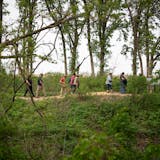Thousands of Minnesota National Guard members and law enforcement officers from all over the state swarmed the streets of Minneapolis and St. Paul as night fell Saturday, quelling some of the unrest that had destabilized the state's two largest cities for several days.
They were on foot and in police cruisers, military Humvees and helicopters, fanning out to try to disperse crowds, to stop looting and violence before it began across both cities. They used tear gas and projectiles and handed out curfew violations instead of waiting to contain unrest.
By Sunday morning, Gov. Tim Walz was hailing a night of restored, if not fragile, order in the Twin Cities. Sunday into Monday loomed as an immediate test of whether that could hold, with huge crowds still out demonstrating and frequent tense flare-ups.
Walz thanked "our neighbors and our public servants" for a night that passed without fatalities and minimal property damage, the result of what he called "the most complex public safety operation in our state's history."
Col. Matt Langer, chief of the Minnesota State Patrol, said officers, working under the orders of the governor, were trying to function in "a dynamic, dangerous situation," wearing heavy gear and helmets, with bottles of gas or urine and other things being thrown at them.
"These aren't particularly pretty actions that we take," Langer said.
Law enforcement officials said they were prepared to repeat their efforts Sunday night and into the coming days if needed.
Some tactics drew criticism as authorities moved aggressively to clear streets and break up large groups, with some peaceful demonstrators and, in a few cases, journalists arrested, tear-gassed or injured.
![Three weeks ago, Octavio Rodriguez switched from making transmission parts to casting parts for hospital bed brake assemblies at Twin City Die Castings. ] GLEN STUBBE • glen.stubbe@startribune.com Thursday, April 9, 2020 How employee-owned Twin City Die Casting, which just laid off 40 production workers of its 250 employees in what was supposed to be a good year, is trying to accelerate its pivot to growing medical parts business for ventilators, hospital beds, etc as it copes with instan](https://arc.stimg.co/startribunemedia/WNZYKGTZ5IYMUCO3KI5TR3N7WI.jpg?&w=80&ar=1:1&fit=crop)
djoles@startribune.com As boaters flock to Minnesota lakes and rivers this holiday weekend for the unofficial kick-off to the boating season, they'll face more inspections in and out of the water as local cities and counties ramp up their work to stop the spread of invasive species. Across the metro, more boat accesses will be staffed by watercraft inspectors thanks to $10 million funneled to county government programs this year, up from $4.5 million the state allocated last year. ORG XMIT: MIN1505222156290209 ORG XMIT: MIN1506021218440580](https://arc.stimg.co/startribunemedia/34QSKO44B2XKVNUZCO5SLJQSLY.jpg?&w=80&ar=1:1&fit=crop)

